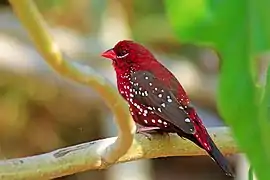| Amandava | |
|---|---|
.jpg.webp) | |
| Male red avadavat (Amandava amandava) | |
| Scientific classification | |
| Domain: | Eukaryota |
| Kingdom: | Animalia |
| Phylum: | Chordata |
| Class: | Aves |
| Order: | Passeriformes |
| Family: | Estrildidae |
| Genus: | Amandava Blyth, 1836 |
| Type species | |
| Amandava punctata = Fringilla amandava[1] Blyth, 1836 | |
| Species | |
|
A. amandava | |
Amandava is a genus of the estrildid finches. These birds are found in dense grass or scrub in Africa and South Asia. They are gregarious seed-eaters with short, red bills. In earlier literature, amadavat and amidavad have been used.[2] The name amandava, along with amadavat and amidavad are all corruptions of Ahmedabad, a city in Gujarat, India from where the first few specimens of the red munia Amandava amandava were obtained.[3]
Taxonomy
The genus Amandava was introduced in 1836 by the English zoologist Edward Blyth for the red avadavat. The genus in mentioned in a footnote to a page of an edition of Gilbert White's The Natural History and Antiquities of Selborne that Blythe edited.[4] The name is derived by tautomony with the binomial name Fringilla amandava introduced for the red avadavat by Carl Linnaeus in 1758. The word amandava is a corruption of Ahmedabad, a city in the Indian state of Gujarat.[5] The genus Amandava is sister to the genus Amadiva containing two African finches.[6]
Species
The genus contains three species:[7]
| Image | Common Name | Scientific name | Distribution |
|---|---|---|---|
 | Red avadavat or red munia | Amandava amandava | Bangladesh, India, Nepal and Pakistan |
 | Green avadavat or green munia | Amandava formosa | central India, around southern Rajasthan, specifically around Oriya village, central Uttar Pradesh, southern Bihar and West Bengal |
.jpg.webp) | Orange-breasted waxbill or zebra waxbill | Amandava subflava | south of the Sahara in Africa |
The two avadavats, which are very closely related, are found in tropical South Asia, and the waxbill in Africa. Various members of this genus are sometimes placed in Sporaeginthus.
References
- ↑ "Estrildidae". aviansystematics.org. The Trust for Avian Systematics. Retrieved 2023-07-16.
- ↑ Newton, A. & H. Gadow. 1896. A dictionary of birds. Black.London. p.11
- ↑ Pittie, Aasheesh (2004). "A dictionary of scientific bird names originating from the Indian region". Buceros. 9 (2): 1–30.
- ↑ White, Gilbert (1836). Blyth, Edward (ed.). The Natural History of Selborne, with its Antiquites; Naturalist's Calendar, &c. London: Orr and Smith. p. 44, Footnote.
- ↑ Jobling, James A. (2010). The Helm Dictionary of Scientific Bird Names. London: Christopher Helm. p. 43. ISBN 978-1-4081-2501-4.
- ↑ Olsson, Urban; Alström, Per (2020). "A comprehensive phylogeny and taxonomic evaluation of the waxbills (Aves: Estrildidae)". Molecular Phylogenetics and Evolution. 146: 106757. doi:10.1016/j.ympev.2020.106757. PMID 32028027.
- ↑ Gill, Frank; Donsker, David; Rasmussen, Pamela, eds. (July 2021). "Waxbills, parrotfinches, munias, whydahs, Olive Warbler, accentors, pipits". IOC World Bird List Version 11.2. International Ornithologists' Union. Retrieved 14 July 2021.
- Clement, Harris and Davis, Finches and Sparrows ISBN 0-7136-8017-2